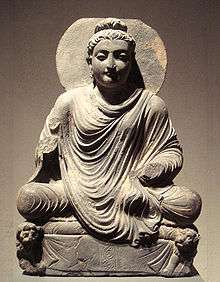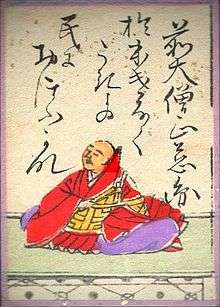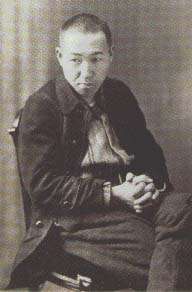Buddhist poetry





Buddhist poetry is a genre of literature that forms a part of Buddhist discourse. The first examples of Buddhist poetry can be found in traditional scriptures such as the Dhammapada, according to which, Siddhārtha Gautama (the founder of Buddhism), upon his reaching enlightenment, proclaimed:
Through the round of many births I roamed
without reward,
without rest,
seeking the house-builder.
Painful is birth
again & again.
House-builder, you're seen!
You will not build a house again.
All your rafters broken,
the ridge pole destroyed,
gone to the Unformed, the mind
has come to the end of craving.[1]
- ^ "House" = selfhood; house-builder = craving. Thanissaro Bhikkhu, Commentary to the Dhammapada, Verses 153-154. "Archived copy". Archived from the original on 2009-01-08. Retrieved 2008-11-22.
Traditionally, most Buddhist sutras have a prose component supplemented by verses (known as gatha) that reiterate and poetically summarize the themes of preceding prose passages. Gatha functions as a mnemonic device helping the Buddhist practitioner commit to memory a certain doctrinal maxim. And in fact, the earliest extant forms of Buddhist discourse appear in verse, which is hardly surprising, considering that the texts were not originally written, but memorized. Linguistic analysis shows that the prose component of the sutras is likely to have been modified by later editing, while the poems often contain earlier forms of language. This view is confirmed by Japanese Buddhist scholar Hajime Nakamura, who states that the verse components of the Pali Canon actually predate the prose components, the former being a way of facilitating memorization, as the Pali Canon was transmitted orally for the first 300 or so years.
Current Buddhology generally maintains that even the liturgical scriptures are products of literary composition. Hence, the study of Buddhist text in general and Buddhist poetry in particular cannot be disengaged from the literary field. But for the sake of classification it is useful to distinguish between
- Buddhist poetry that is attributed to the Buddha himself, which forms a part of "Buddha Speech" (Sk. Buddhavacana), and
- Buddhist poetry written by Buddhists, which is not included in the sutras.
This article concerns primarily with the latter.
Buddhist poetry in Asia
A typical example of a Buddhist poet is Monk Aśvaghoṣa who used his poetic talent and education in Brahmanic tradition to compose poetry on various Buddhist themes, e.g. the life of the Buddha, the Buddhacarita.[1]
Buddhist poetry – like the bulk of the scriptures produced by Buddhists – is not limited to compositions in Pali and Sanskrit; it has flourished in practically every language that Buddhists speak.
- Notable examples in the Tibetan tradition are works of Milarepa.[2]
- Chinese Buddhist Tradition is particularly rich in poetic expression. In the poetry of Bai Juyi,[3] for instance,we see a tension between the secular and Buddhist poetic expression: many Buddhists considered poetry as an attachment and advocated against it, despite the fact that the scriptures revered by them were abundant in poetic forms. Bai is credited with the coinage of the expression kyōgen kigo (狂言綺語, lit. "deranged words and embellished language"), which, to his view, referred to futility of poetic expression in comparison to Buddhist practice. Perhaps, the most successful Chinese Buddhist poet to resolve this paradox was Jiao Ran 皎然 (730-799), who proposed treatment of poetry as an intellectual instrument of Buddhist practice.[4] Chan Buddhism (Ch. Chan; Jap. Zen) provided a rich ground for Buddhist poetry. Chan Buddhists created a complex language in which indirection, suggestion, ambiguity, paradox, and metaphor are prized over straightforward explanation. This complex language of Chan literature is also applied in Chan poetry. Chan Buddhists asserted that though enlightenment cannot be explained in ordinary terms, poetry, as a special language, can point the way. As the Chan monk Juefan Huihong (1071–1128) wrote, “The subtleties of the mind cannot be transmitted in words, but can be seen in words.” In Chan poetry, images as simple as the moon, clouds, boats, reflections in water, plum and lotus, bamboo and pine took on complex connotations based in Chan ideas, famous verbal exchanges, and Chan and Buddhist texts.[5]
To exemplify the use of specialized Buddhist metaphor, this well-known poem by Hanshan (Tang Dynasty) will suffice:
我心如秋月
寒潭清皎洁
无物堪比拟
教我如何言My mind is like the autumn moon,
As fresh and pure as a jade pond.
But nothing really compares with it –
Tell me, how can I explain?
- Korean poets wrote mostly in Classical Chinese.[6]
- Japanese poets also contributed to Buddhist poetic tradition in classical Chinese (e.g. the poetic genius of Kūkai inspired many poets of later generations.)[7] Kūkai, in turn was influenced by Jiao Ran's Shi shi 詩式, as the latter is included in Kūkai's magnum opus of poetics, the Bunkyō hifuron 文鏡秘府論.[8]
In medieval Japan, Buddhist poetry was accorded a special status of a separate genre within the corpus of the waka collections.
Japanese Buddhist Poetry
1. The earliest extant collection of the Japanese poetry, the Man'yōshū, contains a preface (Jp. jo 序 or daishi 題詞) to two poems on the love of parents towards their children: "Sakyamuni expounds truthfully from his golden mouth, 'I love all things equally, the way I love my child, Rahula.' He also teaches that 'no love is greater than the love for ones child.' Even the greatest of saints cherishes his child. Who, then, among the living creatures of this world could fail to love children claimed as one's own?"[9] There are several prefaces and poems in the Man'yōshū that mention the name of Buddha Śākyamuni (Jp. Shaka Nyorai 釋迦如来 /an honorific title of Siddhārtha Gautama), Buddhist temples (Jp. tera 寺), monks and nuns.[10]
2. Among the treasures of Yakushi-ji Temple in Nara there are stone blocks dating from the Nara period modeled as "the footsteps" of the Buddha (Jp. Bussokuseki 佛足石). These blocks contain poems in man'yōgana that may be considered the oldest Buddhist waka (Japanese language poems) known to date. These poems are usually referred to as bussokusekika (lit. "poems on stone imprints of Buddha's feet": 仏足石歌). Consider the following example:
Rōmaji:
misoji amari
futatsu no katachi
yasogusa to
sodareru hito no
fumishi atodokoro
mare ni mo aru ka mo
Rare indeed
are the footprints
where trod the man
who lacked none
of the thirty two marks
and the eighty signs [of Buddhahood].[1]- ^ Adapted from Mills (1960: 237).
Both examples above have one trait in common. Namely, the focus on the physical characteristics of the Buddha is prominent: "the golden mouth" of the Buddha in the Man'yoshu and the "feet of the Buddha" in the stone inscriptions relate to the marks of perfection of the Buddha's body / speech (Skt. mahāpuruṣa, lit. [signs of] "a great person").[11]
In the Heian period, Buddhist poetry began to be anthologized in the Imperial Anthologies (Jp. chokusenshū 勅選集. Among the 21 Imperial Anthologies, 19 contain Buddhist tanka (lit. short waka) starting with the Shūi Wakashū, compiled between 1005 and 1007 C.E.
The first Imperial Anthology to treat Buddhist tanka as a separate genre, i.e. shakkyōka (lit. "Poems of Śākyamuni's Teaching": 釈教歌), is the Senzai Wakashū, which has an exclusive section dedicated to the Buddhist Poems in Volume 19 (第十九巻). Among the most famous poets who wrote shakkyōka are: Saigyō; Jakuren; Kamo no Chōmei; Fujiwara no Shunzei; Jien; Nōin; Dōgen, Ton'a, etc. Many of the so-called "Thirty-six Poetry Immortals" wrote Buddhist poetry.
Shakkyōka can be subdivided according to the ten following motifs:
- Buddhas and bodhisattvas;
- Eminent monks / nuns;
- A passage from a sutra;
- A passage from commentatorial corpus of the Buddhist canon;
- Buddhist Experience (meditative / devotional states);
- Mental states, such as delusion, passion, anger, etc. that are important in the Buddhist discourse;
- Religious deeds;
- Related to temples and shrines;
- Buddhist views of Nature;
- Natural phenomena alluding to Buddhist themes (e.g. transience of flowers blooming)[12]
These motifs are not mutually exclusive and are very often combined within a given poem.
One of the most famous collections of Japanese tanka of the Kamakura period, the Hyakunin Isshu contains several shakkyōka, for instance Poem 95, by Jien (also anthologized in the Senzai Wakashū: 巻十七, 雑中, No. 1137):
おほけなく
うき世の民に
おほふかな
わがたつそまに
墨染の袖Unworthy though I am,
I cast my black robe of a monk
Upon this suffering world,
Living here
On the Mount of Timber.[1]- ^ "Mount of Timber" refers to Mount Hiei. For an alternative translation, cf. Mostow (1996: 421) and U Virginia's project: http://etext.lib.virginia.edu/japanese/hyakunin/frames/hyakuframes.html
In later periods, as tanka was slowly being overshadowed by renga and haiku – the two poetic forms that derived from tanka – such famous poets as "the seven worthies of renga", (Jp. renga shichiken 連歌七賢) of the Muromachi period,[13] Sōgi, and still later, Matsuo Bashō, Kobayashi Issa, among many others, carried on the tradition of Buddhist poetry with their compositions.
菊の香や Kiku no ka ya
奈良には古き Nara ni wa furuki
仏達 HotoketachiIn the city of Nara
Fragrance of chrysanthemums;
Buddhas of yore.[1]- ^ For an alternative translation, see De Bary et al. (2001: 368).
—Bashō
The nostalgic feeling of the ancient capital, Nara – interspersed with the scent of chrysanthemums (symbol of Japanese monarchy) and the old Buddha statues – captures well the aesthetic ideals of sabi and yūgen in this famous haiku. Although these three lines appear to be a mere utterance of almost prosaic quality, the imagery invoked is far from simplistic. Buddhas, emperors, passage of time, the ethereal beauty of flowers that presents itself obliquely, i.e., appealing to scent rather than sight – all suggest that the poet sought to use language as a medium of condensed imagery to map an immediate experience, whose richness can only be read in the blanks.
露の世は露の世ながらさりながら
tsuyu no yo wa tsuyu no yo nagara sari nagara
This world of dew
is just a world of dew,
and yet...
Issa
Here the poet uses the image of evanescence of our world, the dewdrop – one of the classical allegories of the Buddhist teaching – to express grief caused by the death of his daughter. In theory, Buddhism teaches its followers to regard all the vicissitudes of life as transitory and ephemeral, akin to magic apparitions without substance or dewdrops soon to evaporate under the sun. Yet, a father's loss of his child is more than reason can counter.[14]
Buddhist poetry and modernity
As Japan reached the era of industrialized modernity, many of the poets of the Meiji period started to experiment with the European styles of poetic composition. Some poets, notably Miyazawa Kenji—a devout Buddhist who expressed his convictions in his poetry and fiction—often composed poems with Buddhist overtones. His Ame ni mo Makezu (雨ニモマケズ), known to practically every Japanese today,[15] takes its theme (Chapter 14: Peaceful and Joyous Deeds / Jp. Anrakugyō 安楽行) from the Lotus Sutra 妙法蓮華經, which Kenji revered.[16]
Another Buddhist poem that remains well known today, but for non-religious reasons, is the Iroha poem from the Heian period. Originally written in man'yōgana and attributed to Kūkai, this Buddhist poem contains every kana precisely once, and is learned in Japanese primary schools mainly for this reason. Many old-style Japanese dictionaries adhere to the Iroha order.
A modern Indian Sanskrit poet, Vanikavi Dr. Manomohan Acharya, wrote Sri Gautama Buddha Panchakam in simple and lucid Sanskrit through lyrical style.[17]
Bibliography
- J. Breen and M. Teeuwen. Shinto in History : Ways of the Kami. Honolulu: University of Hawaii Press, 2000. ISBN 978-0-7007-1170-3
- G.C.C. Chang, tr. and Milarepa, The Hundred Thousand Songs of Milarepa. Kessinger Publishing, 2006. ISBN 978-1-4254-8688-4
- E. Cranston. A Waka Anthology. Stanford University Press, 1998. ISBN 978-0-8047-3157-7
- W.T. De Bary et al. Sources of Japanese Tradition. 2nd Ed. Vol.1: "From earliest times to 1600." NY: Columbia Univ. Press. 2001 ISBN 978-0-231-12139-2
- M. Gibson and H. Murakami. Tantric Poetry of Kukai (Kobo Daishi), Japan's Buddhist Saint : With Excerpts from the Mahavairocana Sutra and I-Hsing's Commentary of the Sutra. Fredonia, N.Y.: White Pine Press, 2008. ISBN 978-0-934834-67-4
- K. Ishihara 石原清志. Shakkyōka no kenkyū : Hachidaishū o chūshin to shite. 釈教歌の研究 : 八代集を中心として Kyōto : Dōhōsha Shuppan 同朋舎出版, 1980. LCCN: 82-805787 (see Webcat: BN01638497; Worldcat OCLC: 16319140)
- E.H. Johnston, ed. and Asvaghosa. The Buddhacarita or Acts of the Buddha. New Delhi: Motilal Banarsidass Pub, Bilingual ed. 1998. ISBN 978-81-208-1279-6
- J. Konishi and E. Miner. A History of Japanese Literature. Vol. 1. Princeton, N.J.: Princeton University Press, 1984. ISBN 978-0-691-06592-2
- T. Kubo and A. Yuyama (tr.) The Lotus Sutra. Revised 2nd ed. Berkeley, Calif. : Numata Center for Buddhist Translation and Research, 2007. Translation from the Chinese of Kumārajīva. ISBN 978-1-886439-39-9
- W.R. LaFleur. The Karma of Words : Buddhism and the Literary Arts in Medieval Japan. Berkeley: University of California Press, 1983. ISBN 978-0-520-05622-0
- D.E. Mills. "The Buddha's Footprint Stone Poems." Journal of the American Oriental Society, Vol. 80, No. 3 (Jul. - Sep., 1960), pp. 229–242 (Available on JSTOR )
- J.S. Mostow. Pictures of the Heart : The Hyakunin-Isshu in Word and Image. Honolulu, Hawai'i: Univ. of Hawai'i Press, 1996. ISBN 978-0-8248-1705-3
- W.H. Nienhauser Jr. The Indiana Companion to Traditional Chinese Literature. Vol. 1. Indiana University Press, 1985. ISBN 978-0-253-32983-7
- R. Pandey. Writing and Renunciation in Medieval Japan : The Works of the Poet-Priest Kamo No Chomei. Michigan Monograph Series in Japanese Studies. Ann Arbor, MI: Center for Japanese Studies, University of Michigan, 1998. ISBN 978-0-939512-86-7
- N. Sakaki. Inch by Inch: 45 Haiku by Issa. Albuquerque: La Alameda Press, 1999 ISBN 978-1-888809-13-8
- E.U. Ramirez-Christensen and Shinkei. Heart's Flower : The Life and Poetry of Shinkei. Stanford, Calif.: Stanford University Press, 1994. ISBN 978-0-8047-2253-7
- B. Watson, tr. Po Chü-i : selected poems. New York : Columbia University Press, 2000. ISBN 978-0-231-11839-2
- B. Watson, "Buddhism in the Poetry of Po Chü-I." Eastern Buddhist 21, no. 1 (1988): 1-22.
- Egan, Charles, and Charles Chu. "Clouds Thick, Whereabouts Unknown : Poems by Zen Monks of China." New York: Columbia University Press, 2010. ISBN 978-0-231-15038-5
Notes
- ↑ Johnston (1998)
- ↑ Chang (2006).
- ↑ B. Watson (1988, 2000).
- ↑ Nienhauser (1985: 270-2).
- ↑ Egan, Charles, and Charles Chu (2010).
- ↑ I, Yon-suk (1986). "A Study: Aspects of Esoteric Buddhism in Ancient Korean Poetry". Journal of the Academic Association of Koreanology in Japan. 121: 87–118, 3.
- ↑ Gibson and Murakami (2008).
- ↑ More on Kukai's poetry, cf. R.Green: http://ww2.coastal.edu/rgreen/kukaipoetry.htm
- ↑ Preface to MYS 806 tr. in Konishi & Miner (1984: 399).
- ↑ E.g. MYS 3862, 3863; prefaces to MYS 155, 339, 394, 798, 806, 997, 1023, 1561-3, etc. Numbers of the Man'yōshū (MYS) poems follow the new system of the Shinpen Kokka taikan. "Shinpen Kokka Taikan" Henshū Iinkai (hensha). Tōkyō: Kadokawa Shoten, 1983-1992. (Shōwa 58 - Heisei 4). 新編国歌大観. 「新編国歌大観」編集委員会(編者). 東京: Kadokawa Shoten, 1983-1992. (昭和58 - 平成4).
- ↑ for detailed information on the marks of the Buddha's body cf. http://studybuddhism.com/en/advanced-studies/lam-rim/refuge/the-32-major-marks-of-a-buddha-s-physical-body
- ↑ Ishihara (1980: 20-1).
- ↑ Sōzei 宗砌(?-1455), Shinkei 心敬 (1406-75), Gyōjo 行助 (1405-69), Nōami 能阿弥 (1397-1471), Chiun 智蘊 (d. 1448), Senjun 専順 (1411-76) and Sō'i 宗伊/aka. Sugihara Katamori 杉原賢盛 (1418-85?) are "the seven worthies / sages of renga" popularized by Sōgi. Ramirez-Christensen (1994: 54-5).
- ↑ Sakaki (1999: 72)
- ↑ For an alternative translation of this poem, see this site.
- ↑ An online translation of the Lotus Sutra is available at here.
- ↑ http://www.itimes.com/users/iti499967/blog/_193081
External links
| Wikisource has original text related to this article: |
- A Sketch of Buddha's Life: contains many of the early Pali poems.
- The Dhammapada, e.g Buddha's Enlightenment poem: 153-154.
- The Senzaishu in Japanese, cf. Vol 19, 釈教.
- Selected translations and an Introduction to Waka.
- Search Engine of the Man'yoshu in Japanese.
- A fan website on Miyazawa Kenji with translations of works.
- A Buddhist poetry fan site.
- Sacred Poetry from Around the World.
- jeromes niece A collection of poetry Dharma submitted by readers.
- Buddhist Poetry Review
%2C_Late_19th-early_20th_Century%2C_Dhodeydrag_Gonpa%2C_Thimphu%2C_Bhutan.jpg)


